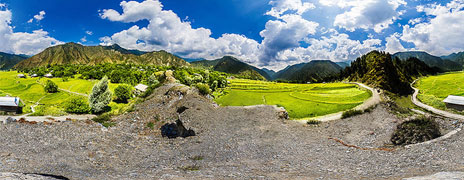Northern India

India bristles with an eclectic mélange of ethnic groups; an intoxicating cultural cocktail for the traveller.
Jammu and Kashmir consists of three regions: Jammu, the Kashmir valley and Ladakh.This was the mountain retreat of Mughals and Buddhist lamas; the Alps of India; Jehangir’s Valley of Paradise. Kashmir boasts some of the highest and most rugged landscapes on earth in mountainous Ladakh, and one of the most sublime in serene Dal Lake. While the Kashmir valley is famous for its beautiful mountainous landscape, Jammu's numerous shrines attract tens of thousands of Hindu pilgrims every year. Ladakh, also known as "Little Tibet", is renowned for its remote mountain beauty and Buddhist culture.
Popularly known as the Devbhumi – "Land of the Gods", Himachal Pradesh is a beautiful hill state in India crowned by the rugged peaks of the western Himalaya.Few other places can match such incredible diversity – rolling foothills, lofty hill stations, traveller towns, serene pine forests, endless apple orchards and the high-altitude deserts of Lahaul and Spiti, cut off from the outside world by snow for six months. The mystique of the mountains is overpowering. The mighty peaks of the Dhaula Dhar, Pir Panjal and western Himalaya ranges rise above Himachal, providing a setting for a host of activities from treks and rafting to skiing and Buddhist meditation. Tibetan Buddhist culture abounds in the ancient monasteries of Lahaul and Spiti and the bustling traveller centre of McLeod Ganj, home to the Dalai Lama and the Tibetan government in exile. Shimla in Himachal Pradesh is India’s most popular hill station. Manali and the Kullu Valley provide a base for hippies, honeymooners and thrill seekers. The lower hills bristle with castles, forts, temples and palaces. There is no wonder Himachal is most people’s favourite northern state!
Delhi – with its tenacious touts and crush of mechanical and human traffic – can be downright confronting and confounding for the first-time visitor. But don’t let petulant first impressions muddy the plus points of this truly multidimensional metropolis. Scratch beyond the gritty surface and you’ll swiftly discover that India’s capital is sprinkled with glittering gems: captivating ancient monuments, magnificent museums, a vivacious performing-arts scene and some of the subcontinent’s yummiest places to eat. Visitors can spend the day immersing themselves in history at the dramatic Red Fort, Jama Masjid and medieval-flavoured bazaars of Old Delhi, and also reviving themselves over frothy cappuccinos or frosty cocktails at one of New Delhi’s swanky cafés and bars.
The magic of vibrant Rajasthan - its heritage, culture, safaris, sand dunes, lush forests and wildlife-makes it destination nonpareil.From the cackle of its colour-charged cities to the luminous splendour of its sun-kissed desert, Rajasthan is romantic India wrapped in gaudy royal robes. Here the fearsome Rajput warrior clans ruled with gilt-edged swords, plundered wealth and blood-thick chivalrous codes. A vast and wonder-laced state with treasures more sublime than those of fable, the Land of the Kings paints a bold image. The Meherangarh Fort looming over bright blue Jodhpur, the giant gold sandcastle at Jaisalmer, the palaces and pageantry of Udaipur and the havelis (traditional, ornately decorated residences) sprinkled through Shekhawati – see them all.There’s also abundant wildlife and warm people, glitz and camels, soulful music, glittering saris, tottering turbans and a surprisingly rich cuisine. Immerse yourself in this incredible state of India!
Nothing draws tourists like India’s most famous icon, the Taj Mahal, and the other Mughal monuments in Agra and Fatehpur Sikri. On the banks of Hinduism’s second-holiest river, the Yamuna, the white-marble Taj stands as an unrivalled monument and architectural wonder. The mighty Ganges – Hinduism’s most sacred river – flows through the state providing a spiritual backbone exemplified by the bathing ghats of Varanasi and the pilgrimage centre of Allahabad – the most auspicious of India’s four Kumbh Mela sites. Sarnath where Buddha first preached his gospel and Kushinagar is where he died are part of UP. Devotees of a different kind are drawn to Mathura and Vrindavan, the birthplace of the God Krishna.
Uttarakhand packs in an incredible amount of adventure and life for travellers. Yoga classes at an ashram in Rishikesh and white-water rafting down the Ganges, trekking in the shadow of the Himalayas, Walk with pilgrims to ancient temples near the source of Ganges and Yamuna Rivers, pray with thousands of devotees on the ghats at Haridwar, put your feet up and relax in its hill stations, ride an elephant and take your camera on a hunt for tigers at Corbett National Park. This is a region where nature takes control – rolling forest-clad hills, snow-topped peaks, rivers, waterfalls, lakes and glaciers. Whatever be your interest, this is one of India’s richest regions for travellers.